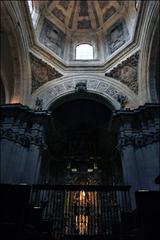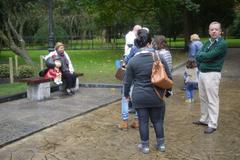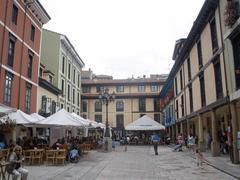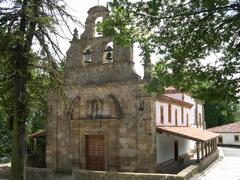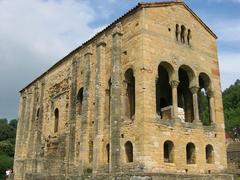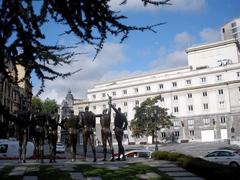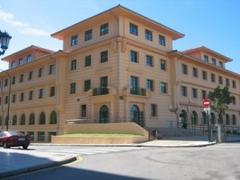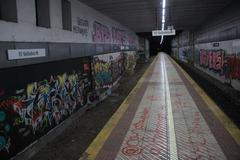
San Vicente of Oviedo: Visiting Hours, Tickets, and Historical Significance Guide
Date: 04/07/2025
Introduction
San Vicente of Oviedo, also known as the Monastery of San Vicente, stands as one of the foundational pillars of Oviedo’s historical and cultural landscape. Established in the 8th century by the monks Máximo and Fromestano, it is widely regarded as the origin point of Oviedo itself—serving as both a spiritual nucleus and the catalyst for the city’s growth as a religious and political hub in Asturias, northern Spain (For91Days). Architecturally, San Vicente is a palimpsest, with layers of Asturian pre-Romanesque, Romanesque, and Gothic styles, each reflecting the dynamic medieval history of the region (Spain.info; Nomads Travel Guide).
Today, the former monastery houses the Archaeological Museum of Asturias, offering visitors a comprehensive journey through the region’s prehistoric, Roman, and medieval past within a setting that is itself a testament to centuries of artistic and spiritual endeavors (Turismo Asturias). As a key stop on the Camino de Santiago and a locus of intellectual activity, San Vicente has influenced religious, cultural, and urban developments that continue to define Oviedo’s identity (Academia Lab).
This guide provides all you need to know about visiting hours, ticketing, accessibility, guided tours, and practical tips, while also exploring the site’s architectural highlights and enduring legacy.
Download the Audiala app for an enhanced experience and consult official resources such as the Archaeological Museum of Asturias and Tourism Asturias for up-to-date information.
Table of Contents
- Early Origins and Foundation
- Role in the Kingdom of Asturias
- Architectural and Artistic Heritage
- Intellectual and Cultural Significance
- Decline, Secularization, and Adaptive Reuse
- Visiting Hours, Tickets, and Accessibility
- Site Layout and Visitor Experience
- Practical Tips for Visitors
- Nearby Attractions and Accommodation
- Visitor Etiquette and Cultural Notes
- Frequently Asked Questions (FAQ)
- Summary and Call to Action
- References and Useful Links
Early Origins and Foundation
San Vicente’s roots trace back to 761 AD, when monks Máximo and Fromestano established a monastery on the site known as Ovetao. The founding charter, the Pacto monástico de Oviedo, marks this moment as the beginning of Oviedo’s transformation from a remote monastic outpost to the capital of the Kingdom of Asturias (For91Days). The monastery was consecrated to Saint Vincent, a Christian martyr and deacon from Valencia, and soon became the nucleus around which the city’s earliest settlements formed.
Role in the Kingdom of Asturias
Under King Alfonso II the Chaste (791–842), Oviedo became the capital of Asturias, and San Vicente assumed a pivotal role as both a religious and political center (For91Days). The monastery’s influence extended throughout the region, forming part of a broader network of pre-Romanesque churches—such as San Julián de los Prados, Santa María del Naranco, and San Miguel de Lillo—that collectively defined the Asturian architectural style (Audiala).
Architectural and Artistic Heritage
San Vicente’s architecture reflects centuries of transformations, with each era leaving its mark.
Pre-Romanesque Foundations
The original structure embodied the Asturian pre-Romanesque style: thick stone walls, small windows, horseshoe arches, and a basilica plan with three naves (Spain.info). Decorative elements blended Visigothic, Mozarabic, and Carolingian influences, while the overall design emphasized simplicity and solidity.
Romanesque and Gothic Transformations
During the 11th and 12th centuries, Romanesque renovations added a barrel-vaulted nave, semicircular apse, and sculpted portals. The Romanesque cloister, with its rounded arches and intricately carved capitals, became a centerpiece of monastic life. Later, Gothic modifications—such as pointed arches and ribbed vaults—further enhanced the church’s structure (PlanetWare).
Artistic Heritage and Notable Artworks
The cloister capitals are adorned with biblical scenes, foliage, and mythical creatures—hallmarks of Romanesque narrative art (Spain.info). Remnants of medieval frescoes in the apse and side chapels evoke the religious devotion of earlier centuries (Nomads Travel Guide). Notably, liturgical objects and relics once held at San Vicente are now displayed in the Archaeological Museum of Asturias (Tourspilot).
Intellectual and Cultural Significance
San Vicente was a center for learning and Enlightenment thought, particularly under Father Benito Jerónimo Feijóo (1676–1764), a renowned Benedictine scholar whose preserved cell and library are now part of the museum (Academia Lab). The monastery’s role in fostering manuscript production, religious art, and intellectual discourse contributed significantly to Oviedo’s cultural legacy.
Decline, Secularization, and Adaptive Reuse
The 19th-century Desamortización led to the secularization and dissolution of many Spanish monasteries, including San Vicente. While the church—now known as Santa María la Real de la Corte—remains active for worship, the cloister and other buildings were repurposed in 1952 to house the Archaeological Museum of Asturias (spain.info). This adaptive reuse has preserved the architectural fabric of San Vicente while opening its history to the public.
Visiting Hours, Tickets, and Accessibility
Location: Calle San Vicente, 3–5, 33003 Oviedo, Asturias, Spain
Museum Opening Hours (Turismo Asturias):
- Tuesday to Saturday: 10:00–13:30 and 16:00–18:00
- Sundays and Public Holidays: 11:00–13:00
- Mondays: Closed
Admission:
- Free (no tickets required for the museum) (Brogan Abroad).
- The adjacent church may have separate hours, especially during services.
Accessibility:
- The museum and cloister are wheelchair accessible, with ramps and adapted facilities. Some historic areas may have uneven flooring; contact staff for assistance.
Guided Tours:
- Available in multiple languages; pre-booking recommended for groups or during peak seasons.
- Informative signage and audio guides may be offered.
Site Layout and Visitor Experience
Cloister and Courtyard
The Romanesque cloister is the heart of San Vicente. The ground floor opens onto a garden via moulded semicircular arches and ribbed vaults, while the upper gallery features distinctive capitals and a stone enclosure. The peaceful setting and medieval details provide an evocative glimpse into monastic life (Turismo Asturias).
Archaeological Museum Exhibits
The museum’s collection spans Asturian prehistory, the Roman era, and the Middle Ages. Highlights include prehistoric tools, Roman mosaics, and artifacts from the Kingdom of Asturias—many discovered during regional excavations (Brogan Abroad).
Church of Santa María la Real de la Corte
Redesigned in the 16th century by Juan de Cerecedo, the church features a single nave, barrel-vaulted ceiling, and side chapels. It houses the tomb of Father Feijóo, a figure central to Spain’s Enlightenment (Turismo Asturias).
Practical Tips for Visitors
- Best Time to Visit: Oviedo’s mild climate and frequent rainfall make San Vicente suitable for year-round visits. The mostly indoor site is ideal for rainy days (Spanish Fiestas).
- Getting There: Located in Oviedo’s historic center, San Vicente is accessible on foot from the main train and bus stations. ALSA buses connect Asturias Airport to the city center (Spanish Fiestas).
- Photography: Permitted in most areas, but flash and tripods may be restricted. Always check signage.
- Accessibility: Ramps and adapted paths are available; inquire for extra assistance if needed.
Nearby Attractions and Accommodation
- Oviedo Cathedral (San Salvador): Gothic masterpiece and starting point for the Camino Primitivo (Brogan Abroad).
- Campo de San Francisco: The city’s main park.
- Calle Uría: Oviedo’s principal shopping street.
- Sidrerías & Restaurants: Sample Asturian cider and cuisine at local favorites (Spanish Fiestas).
- Accommodation: Options range from historic monastery stays (Monasteries.com) to centrally located hotels.
Visitor Etiquette and Cultural Notes
- Dress Modestly: Especially in active church areas.
- Maintain Quiet: The cloister and church are tranquil spaces for reflection.
- Support Heritage: Donations and museum shop purchases aid conservation.
Frequently Asked Questions (FAQ)
Q: What are the visiting hours of San Vicente?
A: The Archaeological Museum of Asturias is open Tuesday to Saturday 10:00–13:30 and 16:00–18:00, Sundays and holidays 11:00–13:00, and closed on Mondays.
Q: Is admission free?
A: Yes, museum entry is free.
Q: Is the site accessible for those with disabilities?
A: The museum and cloister are generally accessible, though some areas have uneven floors.
Q: Are guided tours available?
A: Yes, in multiple languages. Pre-book for groups.
Q: Can I take photos?
A: Non-flash photography is allowed in most areas; check for restrictions.
Summary and Call to Action
San Vicente of Oviedo is a vital emblem of Asturias’ multilayered heritage, reflecting centuries of religious, architectural, and cultural evolution. From its monastic origins to its modern role as a museum, it offers a compelling window into the region’s past and present (For91Days; Academia Lab; Spain.info). Its central location, free entry, and accessibility make it essential for any visitor to Oviedo.
Plan your visit with the latest information via the Audiala app, explore related sites, and immerse yourself in Oviedo’s living history.
References and Useful Links
- Monastery of San Vicente Oviedo: Visiting Hours, Tickets, and History of Oviedo’s Historical Site, Academia Lab
- San Vicente of Oviedo: Visiting Hours, Tickets, and Architectural Highlights, Spain.info
- San Vicente Oviedo: History, Visiting Hours, Tickets, and Must-See Sites, For91Days
- San Vicente Oviedo Visiting Hours & Travel Guide, Turismo Asturias
- Archaeological Museum of Asturias Official Website
- Visit Asturias Tourism
- Spain.info - Asturias Archaeological Museum
- Brogan Abroad: Things to Do in Oviedo
- Audiala: Oviedo City Cultural Heritage
- Monasteries.com: Accommodation in Oviedo
- Spanish Fiestas: Things to Do in Oviedo












